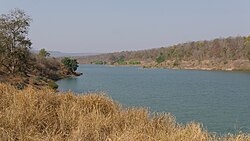Top Qs
Timeline
Chat
Perspective
Panna district
District of Madhya Pradesh in India From Wikipedia, the free encyclopedia
Remove ads
Panna district (Hindi pronunciation: [pənːaː]) is a district of the Sagar Division, within the Madhya Pradesh state in central India. The town of Panna is the district headquarters.
Remove ads
History
Panna district was created in 1950, shortly after Indian independence, from the territory of several former princely states of British India, including the states of Panna, Jaso, most of Ajaigarh, and a portion of Paldeo. Panna District was part of the new Indian state of Vindhya Pradesh, which was merged into Madhya Pradesh on 1 November 1956.
Geography
Panna district lies between 23.45°N 79.45°E and 25.10°N 80.40°E.[1] It has an area of 7,135 km2.[2]
The Ken River flows through the district. The Pandav Falls, The Brihaspati Kund, and the Gatha Falls are located in the district. Panna National Park is a major tourist attraction in the district.[3]
Panna, Ajaygarh, Amanganj and Pawai is major town's of the District
Remove ads
Economy
In 2006 the Ministry of Panchayati Raj named Panna one of the country's 250 most backward districts (out of a total of 640).[4] It is one of the 24 districts in Madhya Pradesh currently receiving funds from the Backward Regions Grant Fund Programme (BRGF).[4] It is among the five poorest districts in the state in terms of income. It ranks 41st out of 45 districts in human development index (HDI) in Madhya Pradesh.[5]
This district has large reserves of diamonds and limestone, some cement factories are operated here. A unit of J.K. Cement is operating here.[6] Udyogiri Puraina is an industrial area in Panna. It is located near Katni, some industrial units are functioning here.[7][8][9]
Divisions
Gram panchayats under Panna district
This intermediate subdivisions are also called block,[10] intermediate panchayat,[11] tehsil[12] or tahsil.[12] Inside Panna district, there are the following nine subdivisions:
Demographics
Summarize
Perspective
According to the 2011 census Panna District has a population of 1,016,520,[15] roughly equal to the nation of Cyprus[16] or the US state of Montana.[17] This gives it a ranking of 442nd in India (out of a total of 640).[15] The district has a population density of 142 inhabitants per square kilometre (370/sq mi) .[15] Its population growth rate over the decade 2001–2011 was 18.62%.[15] Panna has a sex ratio of 907 females for every 1000 males,[15] and a literacy rate of 66.08%. 12.33% of the population lives in urban areas. Scheduled Castes and Tribes made up 20.46% and 16.81% of the population respectively.[15]
Languages
At the time of the 2011 Census of India, 69.08% of the population in the district spoke Hindi and 29.73% Bundeli as their first language.[18]
Among Panna's languages is Bundeli, which has a lexical similarity of 72–91% with Hindi and is spoken by about 3 million people in Bagelkhand.[19]
Remove ads
Mining
Panna district is famous for its diamond mines located in a belt of about 80 km across the Panna town.[2] In olden days the most productive mines were located in the village of Sukariuh.[20] Nowadays, Majhagaon is the only active diamond mine in Asia.[21]
Tourist places
- Ajaygarh Fort, This fort was very important during the half period of Chandela rule. This fort is situated on the top of the Vindhya hills. The fort has two entrances. There is a gate in the north of the fort and Tarhauni gate in the south-east. To reach the doors one has to climb a steep rocky slope of 45 minutes. There is a lake named Ajay Palaka Talav in the middle of the fort.
- Panna National Park, Panna is the twenty-second tiger reserve of India and the fifth of Madhya Pradesh. The reserve is located in the Vindhyan Range and extends across Panna and Chhatarpur districts in the north of the state. Panna National Park was created in 1981. It was declared a Project Tiger Reserve by the Government of India in 1994.
- Raneh Falls, a waterfall on Ken River. The Ken River forms a 5 kilometres (3.1 mi) long, and 30 metres (98 ft) deep canyon made of pure crystalline granite in varying shades of colours ranging from pink and red to grey. There is a series of waterfalls in the canyon. The larger and smaller falls run all through the year. Other seasonal falls appear during monsoons.
- Jugal Kishor Mandir, The idol kept in the sanctum sanctorum of this temple has been brought from Brindavan via Orchha. Swami's jewellery and attire reflect the Bundelkhandi style. The temple has all the architectural features of Bundela temples, including a nata mantapa, bhog mantapa and pradakshna passage.
- Prannath Mandir, Mahamati Prannathji Temple is an important pilgrimage site for Pranamis and attracts large number of devotees during Sharad Purnima. It is believed that Mahamati Prannathji lived at that place for 11 years after which he took Samadhi inside one of the domes of this temple. The temple was built in 1692 and has Muslim and Hindu architectural styles in its domes and lotus structures.
- Nachna Kuthara Mandir, The Nachna temples are of various types dating back to the Gupta Empire era of the 5th or 6th century. Chaturmukh temple dates back to the 9th century. These temples reflect the North Indian style of Hindu temple architecture.
Remove ads
Villages
- Jaruapur
- Muhandra
References
External links
Wikiwand - on
Seamless Wikipedia browsing. On steroids.
Remove ads






